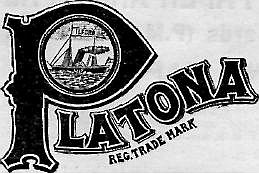| Platona printing paper Britannia Works Company Limited |
|
|
|
|
Since initially uploading this page (October 2008), a better example of a Platona tin has been found by Brian Rees (March 2013). Scroll down the page to view the more legible label on this newer find. To view an Ilford 1908 instruction leaflet for Platona (also found by Brian Rees), click here. |
|
| Platinotype: The following is taken from the 'Readers Ask' column, written by Neville Maude, in Amateur Photographer magazine for 7th March 1962. | |
|
A contact printing process (from the time when negatives were large enough to make sizeable contact prints) based on the reduction of a ferric salt to ferrous by the action of light. The ferrous salt was used to reduce a platinum compound e.g potassium chloroplatinite, to the platinum metal that then formed the image. Good points were the great permanence of the image and the way it lay on the natural suface of the paper. Very hard negatives were needed. Moreover, platinum is expensive and much goes down the drain with each print. Palladium has been used as a substitute, but even this is expensive. The Platinotype process is
being researched by Constance (Connie) McCabe, Head of Photograph
Conservation, National
Gallery of Art, Washington, DC and in the UK by Dr
Mike Ware. In the magazine "The Amateur Photographer & Cinematographer" (prior to it becoming "Amateur Photographer") on p409 of Wednesday June 21st 1944 issue, in "Do You Know?", the process which was the fore-runner to Platinotype is said to have been the Kallitype, by W.W.Nicol. |
|
|
The Platona tin, made by Huntley, Boorne and Stevens, Reading, measures some 170mm long and 65mm diameter. The screw top lid has side pieces that provide a grip and enable it to be tightend and loosened more easily. Inside the lid is a sealing ring that compresses against the top of the tube and prevents the paper from completely drying out. |
|
|
|
The lid (left) and the label (above) both show the tin to have been sold by The Britannia Works Company Limited of Ilford, London. This dates the tin to around 1899-1900. |
 |
PURE PLATINUM PAPER AT POPULAR
PRICES. DIRECTIONS. |
| DEVELOPING
FORMULA Stock Solution. Potassium Oxalate 2ozs. (70 grammes); Potassium Phosphate ½oz (17 grammes); Water 14ozs (500cc) This solution is better if slightly acid, if it is not so, 60 grains (5 grammes) oxalic acid should be added. If unable to obtain Potassium Phosphate, the Sodium Phosphate may be substituted, but the former is preferable. Dissolve the salts in hot water and allow to cool. This solution will keep indefinitely. For use take 1 part Stock Solution and 1 part Water. Develop in weak daylight or in artificial light, floating the prints face downwards in the solution. The image does not lose in fixing. FIXING. Pure Hydrochloric Acid 1oz. (12cc); Water 80ozs. (1000cc) Immerse prints for about five minutes each in three consecutive baths, and then give them a final washing in water for 15 minutes. The prints are then ready to be dried and mounted. |
|
| The above tin is believed to have held whole plate sized paper, maybe 20 sheets and priced at 4shillings (20p) in 1900. This site suggests the current price equivalent would be £20. | |
| The pictures below are of a smaller tin, 4.75inches long x 2.5inches body diameter (120mm x 65mm diameter), which held 20 sheets of paper, sized 6inches x 4.25inches (152mm x 108mm). It cost 2shillings (10p). It is in rather better condition and the label contents can be read all around. My thanks to Brian Rees for allowing me to borrow this tin and show it on my web site. | |
|
|
|
|
|
|
_close.jpg) |
|
|
|
Notice the rubber seal ring inside the lid circumference, to retain moisture in the paper. |
|
|
|
|
|
|